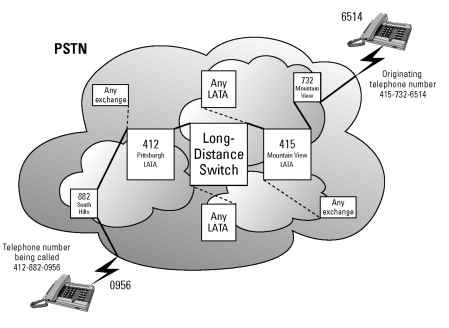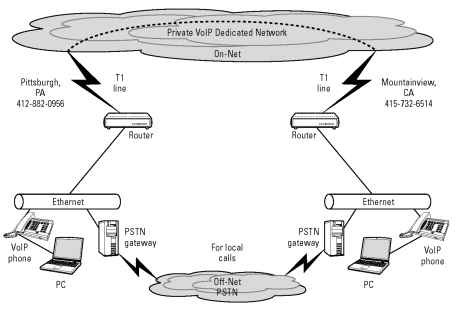When digital networks were implemented back in the 1960s, the telephone carrier companies began using a technique that permitted them to accept analog telephone calls coming into their switching facilities and convert those signals into digital form for transmission on their shiny new networks. They had not yet made the leap into packetizing telephone calls, which is what we have today with VoIP. At the time, they thought it best to keep the circuit-switched telephone carrier network physically separate from the evolving packet-switched computer network.
The phone companies were able to make other improvements to circuit-switched telephone services. After their circuit-switched carrier network received the caller’s telephony signals, they were able to convert the signals into digital form, as necessary. They discovered that digital signals allowed them to aggregate many more calls onto a given circuit and through a given switch than they could before. This enabled them to streamline how circuit-switched telephone calls could be made.
One innovation was the addition of area codes, which help to process calls over a circuit-switched network. The entire telephone number, including area code, identifies the number of circuits and the location of the switching devices for a given phone on the PSTN network. For example, consider a call originating in Mountain View, California (area code 415) to a person in Pittsburgh, Pennsylvania (area code 412). The call is switched out over three physically distinct circuit switches — 415 to 412 — to set up and carry the call. Figure 2-2 illustrates the routing of such a circuit-switched call.

Figure 2-2: Routing a call from area code 415 to area code 412.
If these two locations are on the same computer network, and both are using VoIP, the call could be carried over the company’s computer network in packet form. This process is known as on-net VoIP telephony. None of the packets would touch the PSTN. There would be no toll, regulatory, or metered charges for this long-distance telephone call. Figure 2-3 illustrates the routing of such a packet-switched VoIP call.

Figure 2-3:Routing a call across a VoIP network.
The circuit-switched network gets organized
As circuit-switched networks continued to evolve, other technologies were developed that helped the carriers manage their telephony operations. Carriers began offering more types of POTS access and POTS carrier services.
The early forms of local and long-distance carrier services had to be redefined according to where the carrier company had facilities to terminate the circuits and transport lines, as well as where they might install their facilities. In addition, government regulation of telecommunications picked up. The concept of a local access and transport area, or LATA, as a geographical designation was defined. Eventually, the entire map of the United States would be developed into thousands of LATAs. You can usually identify a particular LATA by the area code associated with a telephone number.
The big advance with LATA was that it helped carriers get organized in a manner that would let them offer other types of carrier services, including those outside the circuit-switched services of the PSTN. For example, a numbering plan was developed that identified any circuit or access transport by its area code and the prefix of the main telephone number. The area code became known as the NPA, for numbering plan area, and the prefix became known as the NXX, for number exchange. For example, the NPA-NXX 412-882 is the area code and prefix for the Pittsburgh 412 LATA and switch 882, located in the South Hills of the Pittsburgh 412 LATA.
What does the NPA-NXX number have to do with VoIP? In topic 7, I discuss dedicated networks that have proven to be the highest quality of service (QoS) network type for VoIP networks. All carrier lines for a dedicated VoIP network are priced using the NPA-NXX of each location included in the network.
Following the development of digital services, the corporate sector began demanding more bandwidth from carriers to support their networks. It didn’t take long for carrier companies to develop digital, high-bandwidth transport lines that could meet the diverse needs of the corporate sector.
These newer transport lines would be digital all the way from a customer’s location A to the same customer’s location B, regardless of how many miles were in between. These customer demands led to the development of transport services that multiplied exponentially the amount of available digital bandwidth that could be offered to the corporate sector.
These newer ultrahigh-bandwidth transports were not the same kinds of wires as those in the POTS network. They were usually a thicker-gauge wire or fiber-optic cables. When installed, they connected two or more locations of a customer’s company in a point-to-point fashion versus the circuit-switched method of the PSTN.
These developments contributed to the emergence of private dedicated networks, which in turn ensured that VoIP would be here to stay. (As you find out in later topics, VoIP becomes a viable option for companies only when used over dedicated networks.) Eventually, on-net VoIP over dedicated networks will replace expensive circuit-switched calling over the PSTN.
The digital services carrier network
The new types of digital lines installed by the carriers began to form a new physical carrier services network. The lines did not cross-connect or intersect with any of the millions of circuit-switched lines that are in place and continue to be installed by the carriers. At the carrier company’s facilities, newer types of fully digital equipment terminated these digital lines.
This new carrier services network was called the digital services carrier network. (It is also known as the digital signal carrier network, or simply as the DS.) This network used higher-bandwidth digital lines and operated with packet-switched protocols to network computer data. (For more on protocols, which are simply rules for using the network, see topic 1.)
Soon thereafter, the DS network was defined based on its fundamental unit of bandwidth, known as the channel. The smallest channel unit provided a bandwidth of 64 Kbps (64 thousand bits per second). This channel was called a DS0, pronounced “D-S-zero.” (Many computer gurus start counting with 0; it’s a binary thing.) DS0 became the base unit of bandwidth from which other dedicated transports were defined. (In topic 7, I cover the popular DS standards in detail.)
The DS network also introduced to the telecommunications vocabulary another term that characterizes most of the transport mechanisms that are not part of the older circuit-switched network. Because the lines used by the DS carriers were installed between private customer locations and the public at large could not use or connect to them, DS lines became known as dedicated to the customer leasing them. The entire series of DS standards eventually became known as the dedicated carrier services network.
